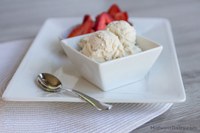Prairie Fare: July is National Ice Cream Month
(Click an image below to view a high-resolution image that can be downloaded)
By Julie Garden-Robinson, Food and Nutrition Specialist NDSU Extension Service
“Mongoose tracks,” the text from my 14-year-old daughter said.
“OK,” I texted back.
I knew exactly what her text message meant. No, we didn’t have a furry critter leaving tracks in our backyard. I would have been calling an animal control agency if that were the case.
The text meant she wanted me to stop at the grocery store for her favorite ice cream, which she has nicknamed. It’s chocolate ice cream with chocolate chunks. Do you think she has a favorite flavor?
Ice cream is the favorite food indulgence in my home, especially for my daughter and husband. I usually do not get a taste unless I serve myself immediately upon arriving at home from the grocery store. My daughter is very disappointed if I pick out ice cream because I like homemade vanilla ice cream best.
In fact, vanilla is the favorite ice cream flavor in the U.S., followed by chocolate, cookies and cream, mint chocolate chip and chocolate chip cookie dough. New flavors regularly appear in the ice cream aisle.
Americans love ice cream. On average, we enjoy about 23 pounds of ice cream per person per year, according to the International Dairy Foods Association. American ice cream companies manufactured nearly 900 million gallons in 2015.
July is National Ice Cream Month and was given that designation in 1984 by then-president Ronald Reagan. He must have had a sweet tooth because he also made a particular brand of jelly beans a household name.
Ice cream has been around since the second century B.C., according to historians. The first “ice cream” was probably snow from high in the mountains topped with juice. Technically, that would be a “snow cone,” not ice cream, according to today’s definitions.
Ice cream is just one of the foods in the “frozen desserts” category. Go into any large grocery store and you will find a wide array of frozen desserts from which to choose. The title you read on the front of the frozen desserts container is defined by federal law.
“Ice cream” must contain at least 10 percent milkfat. “Light” ice cream must have at least 50 percent less fat, and “low-fat” ice cream has a maximum of 3 grams of fat per serving. Some ice cream is categorized as “premium” or “superpremium.” These designations mean the ice cream is higher in fat and has less air (“overrun”) incorporated into the product and usually costs more.
You might notice products labeled “frozen custard.” This designation means the product must contain at least 1.4 percent egg yolk solids.
To enjoy ice cream at its best quality, add it to your cart last on a grocery shopping trip. Be sure the frozen desserts, including ice cream bars, are below the “fill line” if they are stored in a chest-style grocery store freezer.
Bring an insulated grocery bag or cooler if you have a distance to travel. Store ice cream at 0 F or lower in the main compartment of the freezer. Avoid placing ice cream in your freezer door, which may have temperature fluctuations. When ice cream softens or melts, it can become grainy in texture because ice crystals develop when it refreezes.
Whether you like “mongoose tracks” ice cream or plain old vanilla, enjoy a little ice cream now and then as a special treat. Try making this kid-friendly recipe courtesy of the Midwest Dairy Association on a hot summer day. This recipe is lower in fat and calories because it is made with milk instead of cream.
Squeeze Freeze Homemade Ice Cream
1 Tbsp. sugar
1/2 tsp. vanilla extract
1/2 c. whole milk
Small resealable plastic bag (pint size)
Large resealable plastic bag (gallon size)
Ice cubes
Salt
Optional: fresh fruit, chocolate syrup, etc.
Put sugar, vanilla and milk into small plastic bag. Remove as much air as possible from the bag and properly seal. Put 1 tablespoon salt into large plastic bag. Drop the small bag into the large plastic bag with salt in it. Add 18 to 20 ice cubes. Remove as much air as possible from the large bag and properly seal. Knead the bag for approximately 10 minutes, making sure ice in the larger bag surrounds the smaller bag. When a soft ice cream is formed, remove small bag from large bag, open and eat right out of bag with a plastic spoon. For extra fun, add fresh seasonal fruit or other favorite ice cream toppings.
Makes one serving with 130 calories, 4 grams (g) fat, 4 g protein, 19 g carbohydrate, 0 g fiber and 55 milligrams sodium.
(Julie Garden-Robinson, Ph.D., R.D., L.R.D., is a North Dakota State University Extension Service food and nutrition specialist and professor in the Department of Health, Nutrition and Exercise Sciences.)
NDSU Agriculture Communication - July 20, 2017
| Source: | Julie Garden-Robinson, 701-231-7187, julie.garden-robinson@ndsu.edu |
|---|---|
| Editor: | Ellen Crawford, 701-231-5391, ellen.crawford@ndsu.edu |



